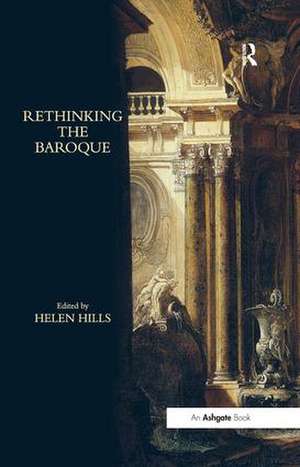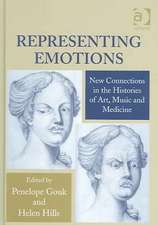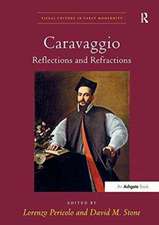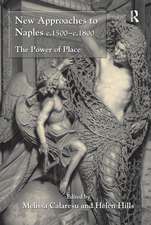Rethinking the Baroque
Editat de Helen Hillsen Limba Engleză Hardback – 19 aug 2011
| Toate formatele și edițiile | Preț | Express |
|---|---|---|
| Paperback (1) | 324.84 lei 6-8 săpt. | |
| Taylor & Francis – 9 sep 2016 | 324.84 lei 6-8 săpt. | |
| Hardback (1) | 1040.64 lei 3-5 săpt. | +30.95 lei 7-13 zile |
| Taylor & Francis – 19 aug 2011 | 1040.64 lei 3-5 săpt. | +30.95 lei 7-13 zile |
Preț: 1040.64 lei
Preț vechi: 1143.57 lei
-9% Nou
Puncte Express: 1561
Preț estimativ în valută:
199.12€ • 208.46$ • 164.76£
199.12€ • 208.46$ • 164.76£
Carte disponibilă
Livrare economică 15-29 martie
Livrare express 01-07 martie pentru 40.94 lei
Preluare comenzi: 021 569.72.76
Specificații
ISBN-13: 9780754666851
ISBN-10: 0754666859
Pagini: 320
Ilustrații: Includes 25 colour and 34 b&w illustrations
Dimensiuni: 156 x 234 x 21 mm
Greutate: 0.75 kg
Ediția:New ed
Editura: Taylor & Francis
Colecția Routledge
Locul publicării:Oxford, United Kingdom
ISBN-10: 0754666859
Pagini: 320
Ilustrații: Includes 25 colour and 34 b&w illustrations
Dimensiuni: 156 x 234 x 21 mm
Greutate: 0.75 kg
Ediția:New ed
Editura: Taylor & Francis
Colecția Routledge
Locul publicării:Oxford, United Kingdom
Cuprins
Contents: Section I Rethinking the Baroque: Introduction: Introduction: rethinking the Baroque, Helen Hills; The Baroque: the grit in the oyster of art history, Helen Hills. Section II Baroque as Style: On sculptural relief: malerisch, the autonomy of artistic media and the beginnings of Baroque studies, Alina Payne; Ottoman Baroque: the limits of style, Howard Caygill. Section III Rethinking Baroque Art History: Discomfited by the Baroque: a personal journey, Thomas DaCosta Kaufmann; Reframing the Baroque: on idolatry and the threshold of humanity, Claire Farago. Section IV Baroque Traditions: Nicholas Hawksmoor's drawing technique of the 1690s and John Locke's Essay Concerning Human Understanding, Anthony Geraghty; The real in the Rococo, Glenn Adamson. Section V Benjamin's Baroque: Benjamin and the Baroque: posing the question of historical time, Andrew Benjamin. Section VI Baroque Folds: Baroque matters, Mieke Bal; The Baroque fold as map and as diagram, Tom Conley; Bibliography; Index.
Notă biografică
Helen Hills is Professor of Art History at the University of York, UK. She has published widely on seventeenth-century Italian architecture, including Invisible City: the architecture of devotion in aristocratic convents in baroque Naples. She is the editor of Architecture and the Politics of Gender in Early Modern Europe (Ashgate, 2003) and co-editor of Representing Emotions (Ashgate, 2005).
Recenzii
Winner, Paul Mellon Centre Publication Grant
'The baroque - the concept, not the period - has had a paradoxical destiny in the last few decades. Prudently shunned by academic historians of seventeenth-century European art and culture, it reemerges regularly - if uncritically - in textbooks and art exhibitions, on the one hand, and as an adjective in discussions of contemporary, postmodern culture on the other. Rethinking the Baroque from a serious, scholarly point of view, is thus a well-needed enterprise, and this collection of essays by some of the most important thinkers of our time marvelously tackles the task.' Renaissance Quarterly
'... this book’s greatest contribution is that it prompts historians of Baroque art and architecture to look again at the term and its implications, and with the aid of Deleuze’s "fold" reassess the period through the prism of its very construction and history as an archive worthy of study.' The Burlington Magazine
'Perhaps we sympathize with the baroque today because, as participants in a postmodern world, we are painfully aware of being suspended between the epistemological and the ontological-that is, between the way things seem and the way they are. We can no longer speak of the past in confident positivist terms and are only too cognizant that, like Walter Benjamin, we are blindly collecting shards of history for our own use. The question of what we as scholars, educators, and students do with these fragments is one of the many perplexing ones raised by this stimulating volume.' CAA Reviews
'Hill's purpose in assembling such a vibrant and diffuse collection of essays on the baroque was to 'trouble the smooth waters of a linear historicism' (p. 91), and this collection certainly succeeds in doing that ... Together, the essays offer a stimulating demonstration of the breadth of approach currently being taken in relation to the baroque.' Seventeenth Century
'The baroque - the concept, not the period - has had a paradoxical destiny in the last few decades. Prudently shunned by academic historians of seventeenth-century European art and culture, it reemerges regularly - if uncritically - in textbooks and art exhibitions, on the one hand, and as an adjective in discussions of contemporary, postmodern culture on the other. Rethinking the Baroque from a serious, scholarly point of view, is thus a well-needed enterprise, and this collection of essays by some of the most important thinkers of our time marvelously tackles the task.' Renaissance Quarterly
'... this book’s greatest contribution is that it prompts historians of Baroque art and architecture to look again at the term and its implications, and with the aid of Deleuze’s "fold" reassess the period through the prism of its very construction and history as an archive worthy of study.' The Burlington Magazine
'Perhaps we sympathize with the baroque today because, as participants in a postmodern world, we are painfully aware of being suspended between the epistemological and the ontological-that is, between the way things seem and the way they are. We can no longer speak of the past in confident positivist terms and are only too cognizant that, like Walter Benjamin, we are blindly collecting shards of history for our own use. The question of what we as scholars, educators, and students do with these fragments is one of the many perplexing ones raised by this stimulating volume.' CAA Reviews
'Hill's purpose in assembling such a vibrant and diffuse collection of essays on the baroque was to 'trouble the smooth waters of a linear historicism' (p. 91), and this collection certainly succeeds in doing that ... Together, the essays offer a stimulating demonstration of the breadth of approach currently being taken in relation to the baroque.' Seventeenth Century
Descriere
Retrieving the term 'baroque' from the margins of art history, scholars from a range of disciplines demonstrate that it is a productive means to engage with art history and theory. Rather than attempting to provide a survey of baroque as a chronological or geographical conception, the essays here attempt critical re-engagement with the term 'baroque'-its promise, its limits, and its overlooked potential-in relation to the visual arts.



















